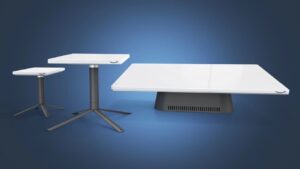Article
Amazon’s Take on Starlink Targeting >$400 Dish for Homes (gizmodo.com)
From the horse’s mouth
Amazon
Here’s your first look at Project Kuiper’s low-cost customer terminals (aboutamazon.com)
What is Amazon’s Project Kuiper? 15 Questions Answered (aboutamazon.com)
My Comments
Amazon have presented the customer satellite terminals for their Project Kuiper low-earth-orbit satellite service that competes with Elon Musk’s Starlink service. Here, they are showing this hardware well before they had launched their prototype low-earth-orbit satellites as part of that platform, something that may be considered too presumptuous.
But rather than offering just one of these terminals that is expected to be an “all-rounder” for the initial offering, Amazon presented three different terminal designs. These terminals use a phased-array antenna approach that covers a flat plate rather than the dish that Starlink went with for their terminal, and this is considered cutting edge for Ka-Band satellite applications.
It is part of a mission statement to offer high-quality satellite broadband Internet for unserved and underserved communities in a manner that is above average.
The first is an affordable terminal designed for use by households and small businesses alike and is equipped with an 11” square antenna plate. This is expected to cost USD$400 and offers a throughput of 400Mbps. The second is a cheaper transportable unit that uses a 7” square antenna and can offer a throughput of 100Mbps. This would be pitched as a budget option or suit “set-up, use, tear-down” transportable operation or something fit for “Internet of Things” use.
They even offered a larger fixed unit with a 19” x 30” rectangular antenna that has a throughput of 1Gbps. This is pitched for use by large businesses, government or telecommunications companies who need to serve many end-users. I also see this unit appealing towards an Internet-access setup with a satellite terminal linked to a fixed-wireline or fixed-wireless connection to households and businesses in a small settlement.
This may show that Amazon may want to offer the satellite Internet service based on the Project Kuiper platform as a wholesale broadband service that other ISPs can sell on a retail level.
All these devices use a phased-array antenna approach that Amazon worked on to improve Ka-band satellite performance along with silicon that Amazon had designed themselves. This is based on Amazon’s experience with hardware and services in the form of the Fire TV set-top boxes and sticks, the Echo smart speakers and displays powered by Alexa and the Eero distributed-Wi-Fi home network platform.
There are questions to be asked about these devices such as whether Amazon is offering all of them as modem-router devices that have a Wi-Fi or Ethernet LAN link or as modem devices designed to be connected to a broadband router that has an Ethernet WAN (Internet) connection. This question would come in to its own with people wanting to use advanced or business-grade routers, including using satellite Internet as a failover means with supported equipment.
As well, there are questions that will come about regarding support for mobile and ad-hoc portable use of Project Kuiper terminals. This includes equipment designed to be installed on a vehicle, vessel or aircraft, using a Project Kuiper service in a moving vehicle, vessel or aircraft or setting up a Project Kuiper terminal anywhere without needing to notify Amazon first. This hasn’t been addressed until a significant number of the satellites are launched and there is a strong customer base.
But what is great about this is that Amazon’s Kuiper satellite system is showing up the forces of competition by offering a varied lineup of customer-use satellite terminals with equipment at affordable prices. This is even before the first satellite has been launched.



